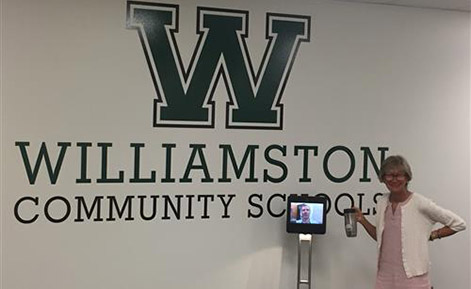When one of Conni Crittenden’s students was missing class due to a medical issue, she knew there had to be a something out there that could help.
She and the student’s parents were doing what they could to make sure the student was keeping up with school—an in-home tutor twice per week, FaceTime with classmates—but they wanted, and needed, a solution that provided more opportunities to feel like the student was actually participating in class.
Then, Conni saw an article about how robots were being used in higher education courses at Michigan State University.
“The more I saw the capability of the robots, the more I wondered: Why wouldn’t we do this?” mused Crittenden, who has been an educator for more than 40 years. “This was a really exciting opportunity.”

Robots from Suitable Technologies are used in courses at MSU.
Digital opportunity
Crittenden, B.A. ’73 (Elementary Education), brought the idea to the student’s parents and the leaders of her school, and then reached out to MSU.
The partnership between MSU and Williamston Community Schools—the first such collaboration for an elementary school in the state—utilizes a Beam Robot, on loan from Suitable Technologies. When unable to attend school in person, the student will be able to log in from home using a free app from any smartphone, laptop or desktop device. Controlled by the student, the robot can move throughout the classroom on two wheels, allowing the student greater freedom and flexibility in interacting with lessons and classmates.
“The goal is to provide this student with greater presence in class than they have been able to have,” said John Bell, educational technology professor and director of the Design Studio, a key collaborator on the project. The Design Studio has incorporated the robots in a variety of capacities during a two-year partnership with Suitable Technologies.
“To this point, all of our research has been with undergraduate and graduate students and courses,” Bell said. “This is a fascinating opportunity to learn more about what happens with younger students, while also bringing real benefit to students today.”
Bell is leading a six-month case study on how the Beam robot not only impacts the student’s learning, but how it impacts the greater class as well. Working with the Synchronous Hybrid Learning and Teaching Experiences (SLATE) graduate student group, they hope to answer: what is the novelty effect for the class, and how long does it last? What is different, better or worse for the student compared to other methods, such as FaceTime? Are effects on social presence similar to what they have found with older individuals?

Crittenden and Bell (via robot) “pose” together at Williamston Community Schools. Bell came to the school via robot to show how the technology worked.
The research is not grant funded, but is being welcomed with open arms by MSU, Williamston schools and the student and family of the student.
“I think my students are excited to be learning about this technology, learning how to adapt to this,” said Crittenden, who adjusted her classroom layout to create wider aisles for the robot to move more easily in. “I’m so glad our administration is open to this opportunity, and willing to explore its benefits.”
Related links
Another 2018 collaboration with Michigan schools brought touchscreen technology to enhance learning in K-12 classrooms.
See the story on the Williamston Community Schools website.
The Design Studio shares videos about how robots are used in MSU classrooms and with research on its YouTube channel.





